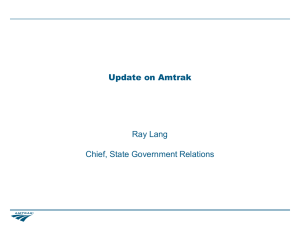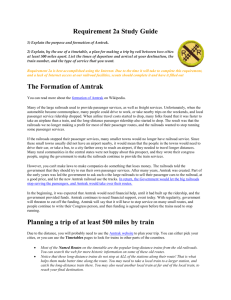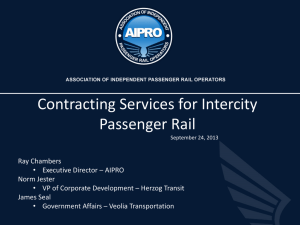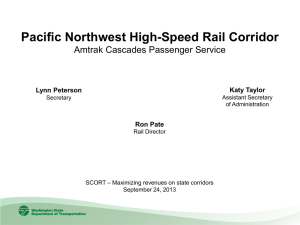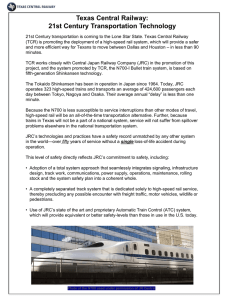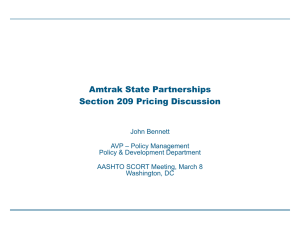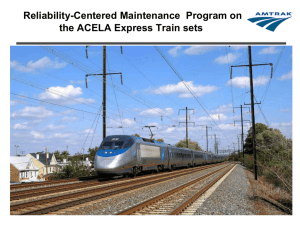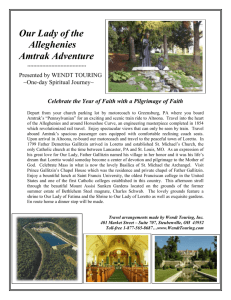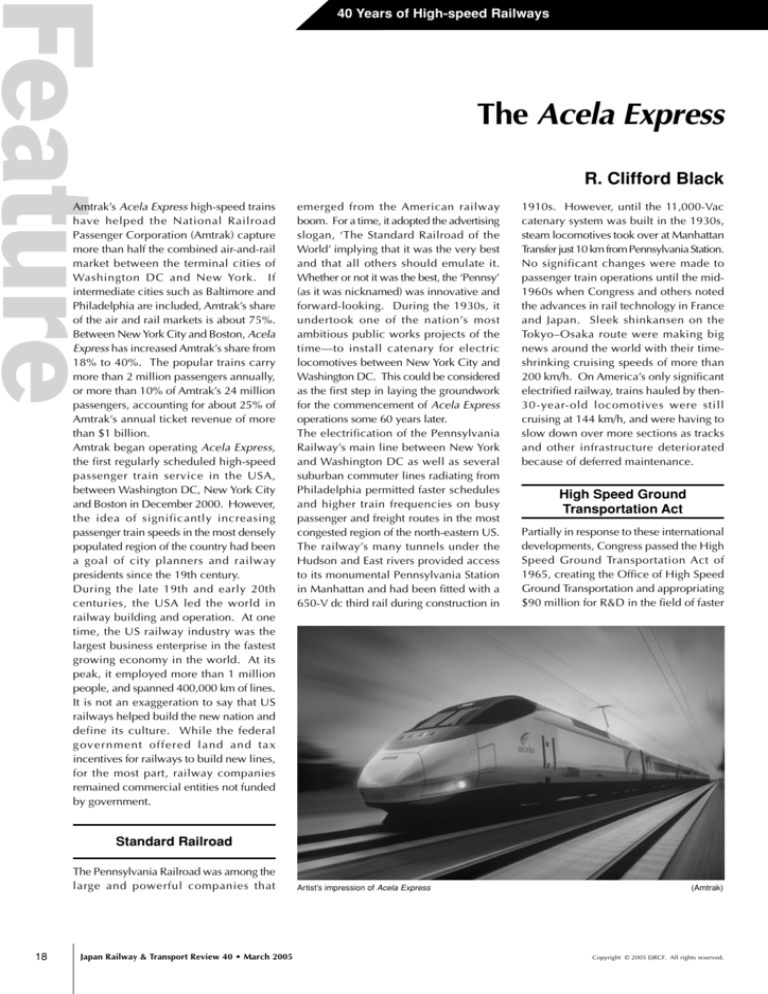
Feature
40 Years of High-speed Railways
The Acela Express
R. Clifford Black
Amtrak’s Acela Express high-speed trains
have helped the National Railroad
Passenger Corporation (Amtrak) capture
more than half the combined air-and-rail
market between the terminal cities of
Washington DC and New York. If
intermediate cities such as Baltimore and
Philadelphia are included, Amtrak’s share
of the air and rail markets is about 75%.
Between New York City and Boston, Acela
Express has increased Amtrak’s share from
18% to 40%. The popular trains carry
more than 2 million passengers annually,
or more than 10% of Amtrak’s 24 million
passengers, accounting for about 25% of
Amtrak’s annual ticket revenue of more
than $1 billion.
Amtrak began operating Acela Express,
the first regularly scheduled high-speed
passenger train service in the USA,
between Washington DC, New York City
and Boston in December 2000. However,
the idea of significantly increasing
passenger train speeds in the most densely
populated region of the country had been
a goal of city planners and railway
presidents since the 19th century.
During the late 19th and early 20th
centuries, the USA led the world in
railway building and operation. At one
time, the US railway industry was the
largest business enterprise in the fastest
growing economy in the world. At its
peak, it employed more than 1 million
people, and spanned 400,000 km of lines.
It is not an exaggeration to say that US
railways helped build the new nation and
define its culture. While the federal
government offered land and tax
incentives for railways to build new lines,
for the most part, railway companies
remained commercial entities not funded
by government.
emerged from the American railway
boom. For a time, it adopted the advertising
slogan, ‘The Standard Railroad of the
World’ implying that it was the very best
and that all others should emulate it.
Whether or not it was the best, the ‘Pennsy’
(as it was nicknamed) was innovative and
forward-looking. During the 1930s, it
undertook one of the nation’s most
ambitious public works projects of the
time—to install catenary for electric
locomotives between New York City and
Washington DC. This could be considered
as the first step in laying the groundwork
for the commencement of Acela Express
operations some 60 years later.
The electrification of the Pennsylvania
Railway’s main line between New York
and Washington DC as well as several
suburban commuter lines radiating from
Philadelphia permitted faster schedules
and higher train frequencies on busy
passenger and freight routes in the most
congested region of the north-eastern US.
The railway’s many tunnels under the
Hudson and East rivers provided access
to its monumental Pennsylvania Station
in Manhattan and had been fitted with a
650-V dc third rail during construction in
1910s. However, until the 11,000-Vac
catenary system was built in the 1930s,
steam locomotives took over at Manhattan
Transfer just 10 km from Pennsylvania Station.
No significant changes were made to
passenger train operations until the mid1960s when Congress and others noted
the advances in rail technology in France
and Japan. Sleek shinkansen on the
Tokyo–Osaka route were making big
news around the world with their timeshrinking cruising speeds of more than
200 km/h. On America’s only significant
electrified railway, trains hauled by then30-year-old locomotives were still
cruising at 144 km/h, and were having to
slow down over more sections as tracks
and other infrastructure deteriorated
because of deferred maintenance.
High Speed Ground
Transportation Act
Partially in response to these international
developments, Congress passed the High
Speed Ground Transportation Act of
1965, creating the Office of High Speed
Ground Transportation and appropriating
$90 million for R&D in the field of faster
Standard Railroad
The Pennsylvania Railroad was among the
large and powerful companies that
18
Japan Railway & Transport Review 40 • March 2005
Artist’s impression of Acela Express
(Amtrak)
Copyright © 2005 EJRCF. All rights reserved.
ground-based transportation. Part of the
funding was invested in a new railway
test facility in Pueblo, Colorado, which
is still busy today as the Transportation
Technology Center, Inc., (TTCI) operated
by the Association of American Railways.
The only facility of its kind in the world,
many foreign rail operators and
manufacturers use the TTCI for various
speed and reliability tests on both
passenger and freight train equipment.
But back in the 1960s, significant
advances in US railway technology were
still a long way off. One experiment in
1966 involved installing twin jet aeroplane
engines on the roof of an old DMU railcar.
The project, which ended almost as soon
as it began, turned out to be more of a stunt
than a test programme. The M-497 test
vehicle attained a respectable speed of
293 km/h on its only run in northern Ohio
on the New York Central Railroad. While
the M-497 never ran again and was soon
scrapped, it still holds the all-time North
American railway speed record.
Metroliner
Meanwhile, the US Department of
Transportation was working on a more
practical approach—a train that became
known as the Metroliner. A consortium
of Westinghouse, General Electric, The
Budd Company, and the Pennsylvania
Railroad, combined their efforts to create
a fleet of 50 stainless-steel EMU units. A
modified train set using these units
attained a speed of 267 km/h in tests on a
specially prepared section in New Jersey.
Regular Metroliner services from January
1969 reached speeds of 176 km/h. In
1983, the Metroliner speed was raised to
200 km/h using more conventional
electric locomotive-hauled coaches.
US passenger rail service was in decline
during the 1960s as a direct result of two
sources of tremendous competitive
pressure. The federal government had
Copyright © 2005 EJRCF. All rights reserved.
committed billions of dollars to a
comprehensive, national Interstate
highway system and commercial aviation
was turning to jet aircraft in everincreasing numbers, serving governmentbacked airports and using
government-backed air traffic control.
Facing this kind of subsidized
competition, and receiving virtually no
federal support, the private US railway
industry was in desperate financial
condition and needed to be relieved of
its loss-making passenger business. To
meet this wish, Congress created the
National Railroad Passenger Corporation
by passing the Rail Passenger Service Act
of 1970. The new passenger rail company
was named Amtrak—a contraction of
‘American travel on track’ and services
started on 1 May 1971.
The Metroliner was among the trains
operated by the fledgling Amtrak on that
first day. They were considered the most
successful passenger trains in the US
because they were relatively fast, ran on
a fairly frequent schedule and enjoyed a
niche market between their terminal cities
of New York City and Washington DC.
The main competition for the largely
business-travel clientele was ‘shuttle’
flights operated by Eastern Airlines
between Washington’s then National
Airport and New York’s LaGuardia Airport.
Already the most densely populated
region of the US, the Northeast Corridor
(NEC) between Washington DC, New
York, and Boston was experiencing
growing congestion on the ground and in
the air, and the term gridlock came into
common usage to describe the mobility
crisis. Clearly, there was need for more and
better transportation options. The Northeast
High Speed Rail Improvement Project
(NEHRIP) was to be part of the solution.
The busiest railway in the western
hemisphere, Amtrak’s NEC between
Washington and Boston had been the only
major AC-electrified passenger line in the
US since the 1930s. In addition to a
tortuous right-of-way engineered in the
19th century, another major technical
shortcoming was the termination of the
electrification at New Haven,
Connecticut, not quite a third of the way
from New York to Boston. The electric
services changed to steam (and later
diesel) at New Haven until the 1910s
when the New York–New Haven section
was electrified. The remaining nonelectrified section had been frequently
seen as a candidate for installing catenary,
but fundiing had always blocked these
proposals. Clearly, to improve speeds, cut
running times and provide efficient service,
the electrification had to be extended east
and north beyond New Haven. This need
was finally met by the NEHRIP.
In the early 1990s, the late W. Graham
Claytor, Jr., Amtrak’s President, Chairman
and CEO urged members of Congress to
give Amtrak money to extend
electrification from New Haven to Boston
and to upgrade signals, track and other
infrastructure in the process. In 1992, he
held a press conference in New York City’s
Pennsylvania Station with US Senator
Frank Lautenberg, Chairman of the Senate
Appropriations Committee. They
announced the NEHRIP plan which
would invest $1.2 billion of federal money
in infrastructure improvements to the
Boston line. But more than just
infrastructure improvements, what
Lautenberg and Claytor wanted was a
programme of study and engineering that
would lead to the acquisition of the Acela
Express high-speed train sets some 7 years
later. (Unfortunately, Claytor died in 1994
before his dream was realized.)
Visits by Foreign Rolling Stock
Later in 1992, in a series of talks with the
representatives of the Swedish State
Railways, Claytor arranged to test
Sweden’s popular new X2000 tilting train
on the NEC. It was both a publicity stunt
Japan Railway & Transport Review 40 • March 2005
19
40 Years of High-speed Railways
Acela Express Route Map
Canada
New York
New
Yor
ork
Philadelphia
Baltimore
Washington
ashington DC
MA Boston-South Station, MA
Boston-Back Bay Station, MA
Boston-Route 128, MA
Boston
NY
CT
Pro
Providence
Providence,
vidence,, RI
RI
Mexico
New London, CT
New
New Haven,
New
Ha en, CT
Newark, NJ
Ne
New
w York-Penn
Yor
ork-P
k-Penn
enn Station
Metropark, NJ
Metropark,
PA
Philadelphia, PA
Princeton Junction,
Princeton
Junction, NJ
Trenton,
renton, NJ
Wilmington, DE
MD
Baltimore
Baltimore,, MD
Airport
Airpor
portt Rail Station
BWI Air
New Carrollton, MD
New
Washington,
ashington, DC
DE
Atlantic Ocean
Source: Amtrak
to draw attention to modern passenger rail
technology being used in other
industrialized nations as well as a method
of collecting engineering data to help
Amtrak write specifications for its own,
specialized high-speed train set. To
demonstrate the public acceptance of
such new technology, ABB (the builder)
arranged with Amtrak to have the train
tour the US, even in regions outside the
electrified NEC, pulled and pushed by
Amtrak diesel and gas turbine locomotives.
It was a popular success, drawing thousands
of spectators wherever it went. For more
than a year, the X2000 periodically
operated in regular service between
Washington DC, New York and New Haven.
During the X2000’s visit, Siemens and
Amtrak agreed to test the new German
high-speed ICE. Both the X2000 and
the ICE train were tested on the NEC—
the X2000 at 248 km/h and the ICE at
265 km/h. In 1993, the ICE also operated
for several months in regular service
between Washington DC and New York.
These tests with Swedish- and Germanbuilt trains were extremely useful in
gauging public response to modern
trains, and all the while they were
undergoing tests, Amtrak’s Engineering
department was studying the new
20
Japan Railway & Transport Review 40 • March 2005
equipment to help Amtrak write
specifications for when the company was
ready to advertise bids to build a uniquely
American high-speed train.
New Specifications
In 1993, when Amtrak asked for bids to
build its new, as-yet unnamed high-speed
trains, three organizations emerged as
qualified bidders: ABB, Siemens, and a
consortium of Bombardier and Alstom.
While there were similarities with existing
trains, the specification package differed
from all other train sets worldwide. They
were to have bi-directional capability with
operating controls at both ends, superior
acceleration and braking, and the ability
to negotiate the numerous curves on the
NEC at higher speeds than conventional
equipment. This latter specification
would require tilting capability. But the
requirement that set these trains apart from
all others was the need to meet crashresistance standards far above anything
else in the world with a buffer strength
requirement in the driver’s cab as high as
544,310 kg, or about twice the
international standard.
In March 1996, Amtrak President Thomas
M. Downs was joined by Al Gore, the Vice
President of the US, and other dignitaries
at Washington DC’s Union Station to
announce the selection of the
Bombardier–Alstom consortium as the
builder of Amtrak’s new high-speed trains.
It was a gala occasion attended by railway
industry executives, government officials
and the press. The consortium was to
produce 18 high-speed train sets (later
increased to 20) and 15 high-horsepower
conventional electric locomotives for
delivery beginning in 1999. Construction
of three special maintenance facilities for
the trains in Washington DC, New York,
and Boston was included. It was a tall
order to design, build and test high-speed
trains designed exclusively for the existing
US railway environment. The deal was
sealed by a consortium loan to Amtrak
that provided the approximately $850
million needed to finance the trains and
maintenance facilities.
A major difference between Amtrak’s Acela
Express and some of the comprehensive
high-speed systems in other industrialized
countries is that the Acela Express was
envisioned and designed as an
incremental improvement over existing
conventional trains. In contrast to Europe
and Japan, without a clear federal policy
on high-speed rail, this choice was made
out of necessity driven by economics and
practicality. The economics resulted from
long-term US public policy that favoured
building Interstate highways for fast and
easy travel by private automobile between
cities. The highway trust fund, financed
by relatively low taxes on petroleum and
diesel fuels, could not be touched for
construction of intercity passenger railway
lines. From a practical standpoint, even
if money was available, the process of
building a new right-of-way though the
most densely populated region of the US
would require acquisition of billions of
dollars worth of real estate and litigation
with the potential for decades of delay.
Consequently, the Acela Express would
Copyright © 2005 EJRCF. All rights reserved.
have to be able to operate over a 19th
century alignment that could not support
a dedicated track, such as that used by
the French TGV or Japanese shinkansen.
Nonetheless, the track, signals and power
supply had to be upgraded and well
maintained in order to realize the benefits
of the new train’s high-performance
capabilities. Concrete ties and
continuously welded rail had already
been installed on some NEC sections
during the 1980s, but more needed to be
done. The NEHRIP project to electrify and
upgrade the route from New Haven to
Boston was proceeding as quickly as
possible while the consortium started
construction of the Acela Express carriage
shells in La Pocatiere, Canada, and final
assembly of carriages in Barre, Vermont,
and locomotives in Plattsburgh, NY. It was
a race to complete the track upgrade and
deliver sufficient train sets to begin
operating Acela Express services by the
goal of 1999.
Despite the 1999 goal, it wasn’t until
March 2000 that George Warrington,
Amtrak President and CEO, announced
to a crowd of front-line Amtrak employees
in New York City that the new trains would
be named Acela based on a combination
of the words acceleration and excellence.
A large screen showed the first view of
the new train as it rolled slowly from the
workshop in Vermont. The media hailed
the event, but the Acela did not become
world news until November that year
when the train made its inaugural run from
Washington DC to Boston. At last, the
US had a high-technology, high-speed
train of which it could be proud, and in
which Amtrak invested a great deal of
hope for its future as a major force in one
of the busiest and most competitive travel
markets in the world. It turned out that
those hopes were well placed.
Copyright © 2005 EJRCF. All rights reserved.
Successful Service Start
The few infrequent Acela services
between Washington DC, New York and
Boston from December 2000, drew large,
admiring crowds. With two sleek,
6000-hp (4474-kW), aerodynamic
power cars sandwiching six passenger
carriages between them, the trains were like
nothing seen in the USA before, even taking
into account the earlier visits by the X2000
and ICE. Four business-class cars, one firstclass car and one café car provided a total
of 304 seats. Some features that
immediately impressed passengers were
the large windows; improved interior
lighting; spacious, attractive restrooms;
electrical outlets at each seat; at-seat food
service in first class; and the smooth, quiet
ride at speeds up to 240 km/h.
As the consortium delivered more train sets,
customers flocked to Acela Express and its
market penetration became so significant
that competitor airlines published critical
newspaper advertisements—the ultimate
expression of flattery for any marketing
department! Thanks to these popular new
trains, Amtrak’s market share continues to
climb in the northeast. After 1999,
Amtrak’s market share between New York
and Washington DC grew from 36% to
53% while the airlines’ share dropped
from 64% to 47%. Amtrak’s share grew
even more dramatically from 18% to 40%
on the New York–Boston section. Of the
total 4.767 million or so combined air and
rail passenger trips in the NEC in the first
quarter of FY2004, fully 2.928 million
(61%) were on Amtrak trains.
Under Amtrak’s President and CEO, David
L. Gunn, Amtrak is embarked on major
infrastructure projects that had been
deferred and whose delay had threatened
the continued reliability of Acela Express
schedules. New concrete ties, welded
rail, ballast-deck bridges, signal systems
and catenary hardware are being installed
incrementally in this busiest and fastest
railway in the NEC, where more than
1000 trains operate each day. With
improved reliability and shorter journey
times, Amtrak is considering increasing
the number of Acela train sets in regular
weekday operation. Currently, 15 train
sets provide 46 weekday departures from
Washington DC, New York, and Boston.
The remaining five sets are assigned to
back-up or programmed maintenance.
Amtrak is studying changing this 15/5
arrangement to 16/4 operation soon.
With the success of Acela, the inevitable
question is when similar services will be
started in other markets around North
America. At present, other projects are
still in planning. As always, costs are a
major consideration and sometimes a
stumbling block. Nevertheless, a broad
range of proposals remains in the concept
stage, including incremental speed
increases in the Midwest and Pacific
Northwest and possible dedicated-rightof-way, high-speed services in California.
The markets are clearly ripe for the US to
expand improved passenger rail services
and the Acela Express has whetted
America’s appetite.
■
R. Clifford Black
Mr Black is Director of Media Relations at Amtrak.
Japan Railway & Transport Review 40 • March 2005
21

